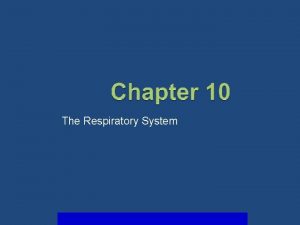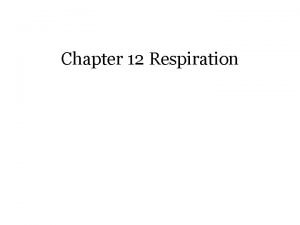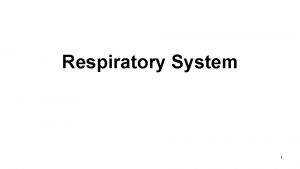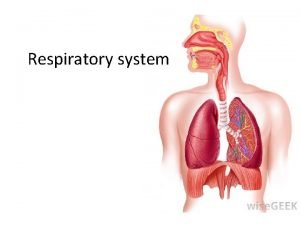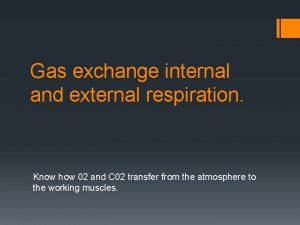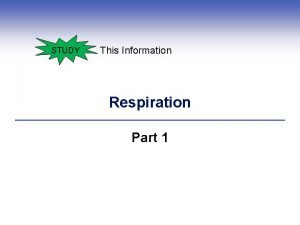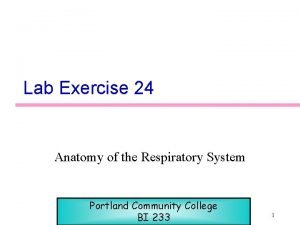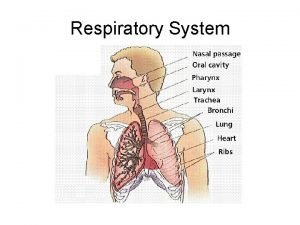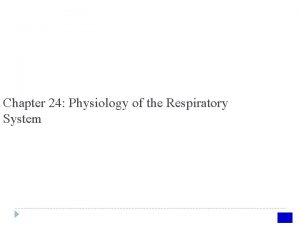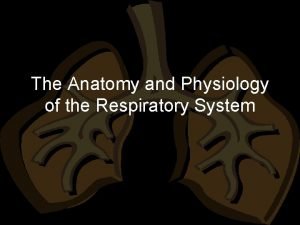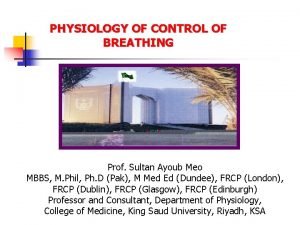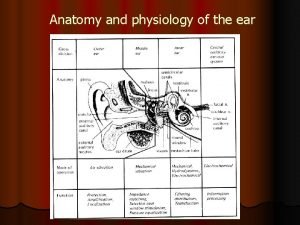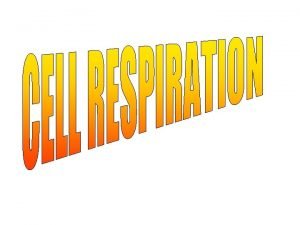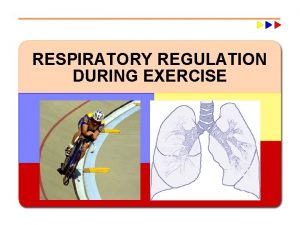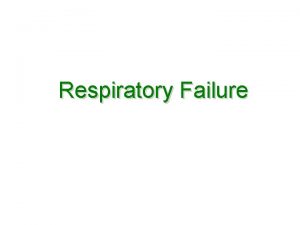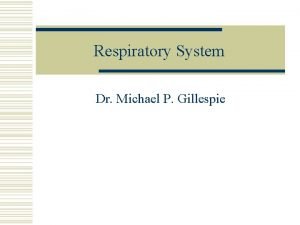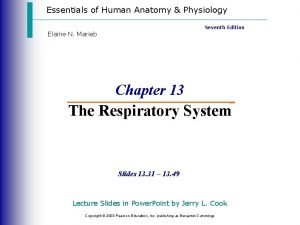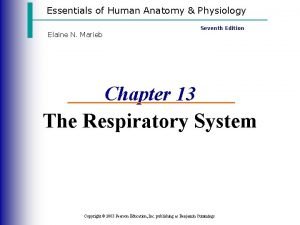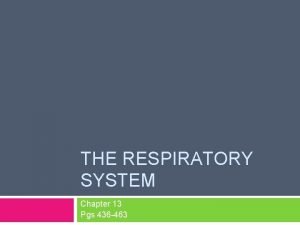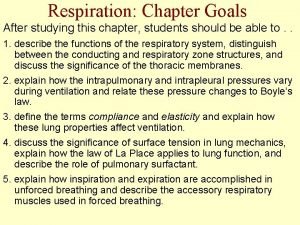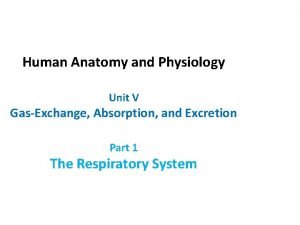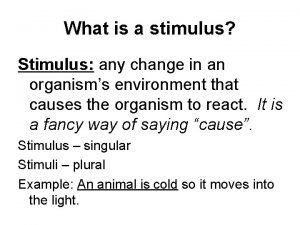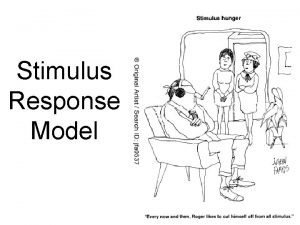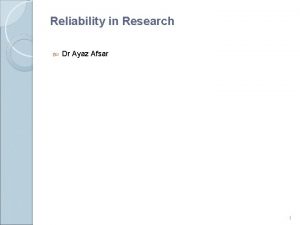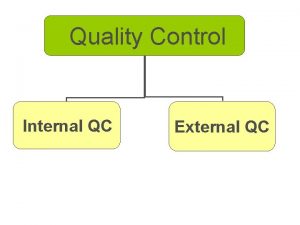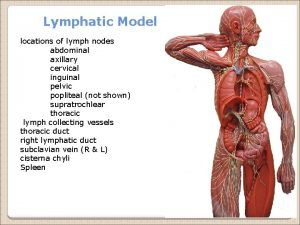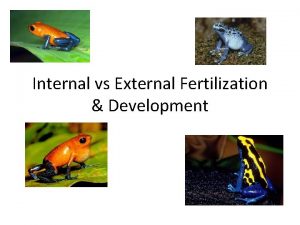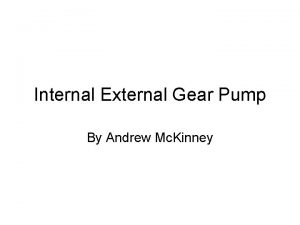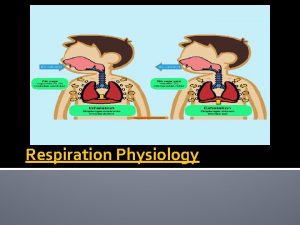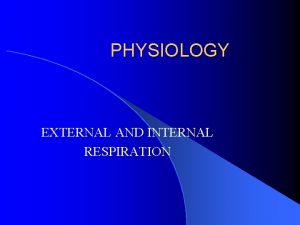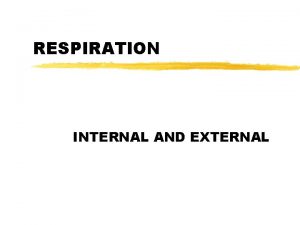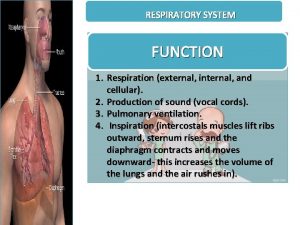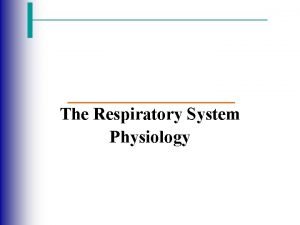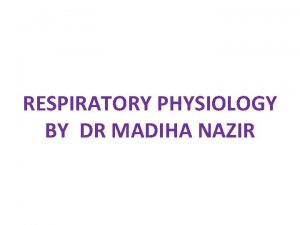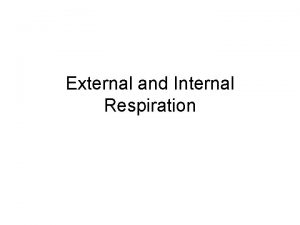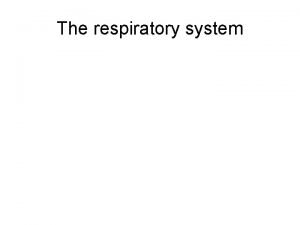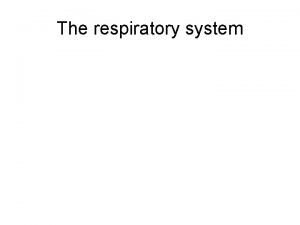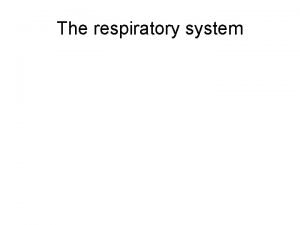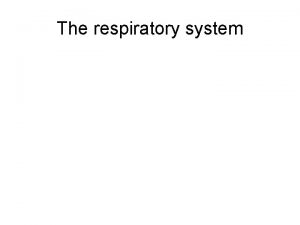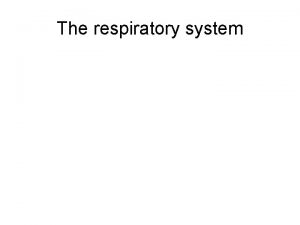PHYSIOLOGY EXTERNAL AND INTERNAL RESPIRATION The Respiratory System

















































- Slides: 49

PHYSIOLOGY EXTERNAL AND INTERNAL RESPIRATION

The Respiratory System l The primary function of the respiratory system is to allow oxygen from the air to enter the blood and carbon dioxide from the blood to exit into the air. l Ventilation, or breathing, has two parts. – Inspiration, or inhaling, conducts air toward the lungs. – Expiration, or exhaling, conducts air away from the lungs.

The Respiratory System l The respiratory system and the cardiovascular system work together to accomplish 1. Exchange of gases (O 2 and CO 2) between air and the blood (external respiration). 2. Transport of gases to and from the lungs and the tissues. 3. Exchange of gases (O 2 and CO 2) between blood and tissue fluid (internal respiration).

4

5

6

7

Anatomy of the Respiratory System l Nasal Concha – Air eddies Air is cleaned l Warmed l Humidified l l Tonsils and Adenoids – Lymph nodes that filter the air – Located in the nose, back of the throat, below the tongue

The Respiratory Tract l As air moves in along the airways, it is: – Cleansed - by nostril hair and cilia and mucus along nasal cavities and trachea; – Warmed – by the heat given off by the blood vessels lying close to the surface of airway lining; – Moistened – by the wet surfaces of the air passages. l As air moves out, it cools and loses moisture.


The Nose l The Nose – Part of upper respiratory tract l Includes nasal cavities, pharynx, and larynx – Air enters through nostrils (external openings) – Contains two nasal cavities Warms and moistens air during inhalation l Contains odor receptors l Tear glands drain into nasal cavity l Separated from mouth by hard and soft palate l

The Pharynx l Pharynx connects nasal and oral cavities to larynx – Three parts Nasopharynx – where the nasal cavities open posterior to soft palate l Oropharynx – where the mouth opens l Laryngopharynx – opens into the larynx l – Uvula - soft extension of soft plate projects into oropharynx – Tonsils - a protective ring l Lymphatic tissue that protects against inhaled microbes


Larynx l Contains Vocal Cords – Connective tissue bands that tighten to create sound when air moves past them l Thyroid Cartilage – Sensitive to Testosterone levels


Copyright © The Mc. Graw-Hill Companies, Inc. Permission required for reproduction or display. base of tongue epiglottis vocal cords trachea © CNRI/Phototake l Larynx – cartilaginous structure – Passageway for air between pharynx and trachea – Vocal cords l Folds of mucosa that vibrate to make sounds – Glottis - opening between folds l Epiglottis – Flap preventing food from entering the respiratory tract Figure 15. 3

17


The Trachea l Trachea (windpipe) cilia goblet cell – Tube connecting larynx to primary bronchi – Held open by C-shaped cartilage rings – Cilia sweep mucus toward the pharynx l Smoking can destroy cilia 3. 5 m

20

Trachea l Conducts Air – Lined with pseudostratified ciliated columnar epithelium – Cilia can be paralyzed by cigarette smoke l Surrounded by C-shaped Cartilagenous rings and the trachealis muscle – Esophagus is dorsal to the trachea l Approximately 4 inches long


The Bronchial Tree l Trachea divides into right and left primary bronchi l Lead into right and left lungs – Branch to secondary bronchi l Eventually lead to bronchioles – As airways divide and subdivide, the walls become thinner l The small rings of cartilage are no longer present – Each bronchiole leads into sac called alveoli

Copyright © The Mc. Graw-Hill Companies, Inc. Permission required for reproduction or display. nasal cavity nostril pharynx epiglottis larynx trachea bronchus bronchiole lung diaphragm a.


The Lungs l The lungs are paired, cone-shaped organs. – Occupy thoracic cavity l Diaphragm separates it from abdominal cavity – Right lung has 3 lobes – Left lung has 2 lobes l Allows room for heart – Each lobe subdivided into lobules l Each lobule has a bronchiole serving many alveoli


The Lungs – Each lung is covered by very thin serous membranes called pleura. – Another pleura covers the internal chest wall and diaphragm. – Both pleura produce lubricating serous fluid that helps the pleurae slide freely against each other during inspiration and expiration. – Surface tension holds the two pleura layers together when the lungs recoil in expiration.

Pleural Membranes l Visceral Pleura – Attached directly to the lungs l Parietal Pleura – Attaches to the visceral pleura – Also attaches to the thoracic cavity l Serous Fluid – Separates the two pleura and lubricates in order to decrease friction – Consistency of egg whites – Pleurisy occurs when the fluid decreases l The Function of the Pleural Membranes is to hold the lungs open

The Lungs l The alveoli are made up of simple squamous epithelium surrounded by blood capillaries. – Gas exchange occurs between the air in the alveolus and the blood in the capillaries. Oxygen diffuses across the walls into blood. l Carbon dioxide diffuses into alveoli. l – Alveoli must stay open to receive air. l Pulmonary surfactant helps prevent them from closing. – Infant respiratory distress syndrome – premature infants lack surfactant


Alveoli l Clustered at the ends of the terminal bronchioles l Makes up the bulk of lung tissue l Primary function is the exchange of gases between themselves and the blood l Surrounded by elastic fibers – Creates Elastic Recoil

Copyright © The Mc. Graw-Hill Companies, Inc. Permission required for reproduction or display. blood flow pulmonary venule pulmonary arteriole blood flow Capillary network of one alveolus


35

Capillaries l The alveoli are closely associated with an extensive network of capillaries – Blood vessels cover 80 -90% of the alveolar surface forming a continuous “sheet” of blood in close contact with the air-filled alveoli


Respiratory Membrane l Consists of – The Wall of the Alveoli – The Respiratory Space This is a fluid filled space l Pneumonia may cause the space to fill with more fluid than normal l – This decreases the ability to exchange gases – The Wall of the Capillary


Alveoli Composed of a single layer of epithelium called Type I cells l Type II alveolar cells l – Secretes surfactant – Surfactant decreases the surface tension of the water within the alveoli – Coats the inside of the alveoli – Cortisol causes the maturation of the type II cells in the fetal stage of development l Dust Cells – Phagocytes

Copyright © The Mc. Graw-Hill Companies, Inc. Permission required for reproduction or display. Inspiration l The active phase – Diaphragm contracts l trachea intercostal muscles Rib cage moves up and out. Becomes flattened – Internal intercostals contract l lungs Raises rib cage up and out Diaphragm contracts and moves down. – Volume of thoracic cavity increases – Air pressure inside alveoli lowers – Air rushes in due to negative pressure Figure 15. 7 a air in lung rib cage pleurae Inspiration When lung volume increases, pressure decreases, and air comes rushing in.

Copyright © The Mc. Graw-Hill Companies, Inc. Permission required for reproduction or display. Expiration l The passive phase – Diaphragm and internal – – Rib cage moves down and in. intercostals relax Recoil returns them to original shape Volume of thoracic cavity decreases Air pressure inside alveoli increases Air rushes out Figure 15. 7 b Diaphragm relaxes and moves up. air out When lung volume decreases, pressure increases, and air is pushed out. b. Expiration

43

44

Gas Exchanges in the Body l Respiration includes the exchange of gases in the lungs (external respiration) and the exchange of gases in the tissues (internal respiration). l Most of the O 2 carried in the blood is attached to the iron-containing heme portion of the protein hemoglobin.

46

47

Emphysema l Loss of elastic fibers for elastic recoil during expiration – Elastin is destroyed by elastase l An enzyme released by immune cells l Have more difficulty exhaling than inhaling

Chronic Obstructive Pulmonary Disease (COPD) l Asthma, emphysema, chronic bronchitis
 Internal respiration vs external respiration
Internal respiration vs external respiration Respiration
Respiration Respiratory system learning objectives
Respiratory system learning objectives Differentiate between external and internal respiration
Differentiate between external and internal respiration Mc respiration
Mc respiration Amloplast
Amloplast Nostrils
Nostrils External vs internal respiration
External vs internal respiration External vs internal respiration
External vs internal respiration Bird respiratory system
Bird respiratory system Tidal volume
Tidal volume Stimulus to breathe
Stimulus to breathe Conductive zone vs respiratory zone
Conductive zone vs respiratory zone Digestive respiratory and circulatory system
Digestive respiratory and circulatory system Dive physiology
Dive physiology What is the physiology of respiration
What is the physiology of respiration Parts of the upper respiratory tract
Parts of the upper respiratory tract Physiology of respiration
Physiology of respiration Apneustic center function
Apneustic center function External publics of a school
External publics of a school Physiology of external ear
Physiology of external ear Circulatory system and respiratory system work together
Circulatory system and respiratory system work together Meaning of cellular respiration
Meaning of cellular respiration Internal respiration
Internal respiration Classification of respiration
Classification of respiration Air path through the respiratory system
Air path through the respiratory system External respiration steps
External respiration steps External respiration
External respiration Internal respiration
Internal respiration Accounting information system chapter 1
Accounting information system chapter 1 Internal respiration
Internal respiration Internal respiration
Internal respiration Internal respiration
Internal respiration How respiratory system work with circulatory system
How respiratory system work with circulatory system Tropism
Tropism Internal users of accounting
Internal users of accounting Key internal stakeholders
Key internal stakeholders Blood glucose stimulus response model
Blood glucose stimulus response model Formal agents of social control
Formal agents of social control Internal and external factors of nationalism
Internal and external factors of nationalism Internal and external reliability
Internal and external reliability External and internal quality control
External and internal quality control Quality control in blood banking pdf
Quality control in blood banking pdf Stakeholders internal and external
Stakeholders internal and external Internal and external nares
Internal and external nares Needs and expectations of interested parties example xls
Needs and expectations of interested parties example xls Internal and external interrupts of 8051
Internal and external interrupts of 8051 Internal vs external fertilization
Internal vs external fertilization What is internal hardware
What is internal hardware Internal external gear
Internal external gear


